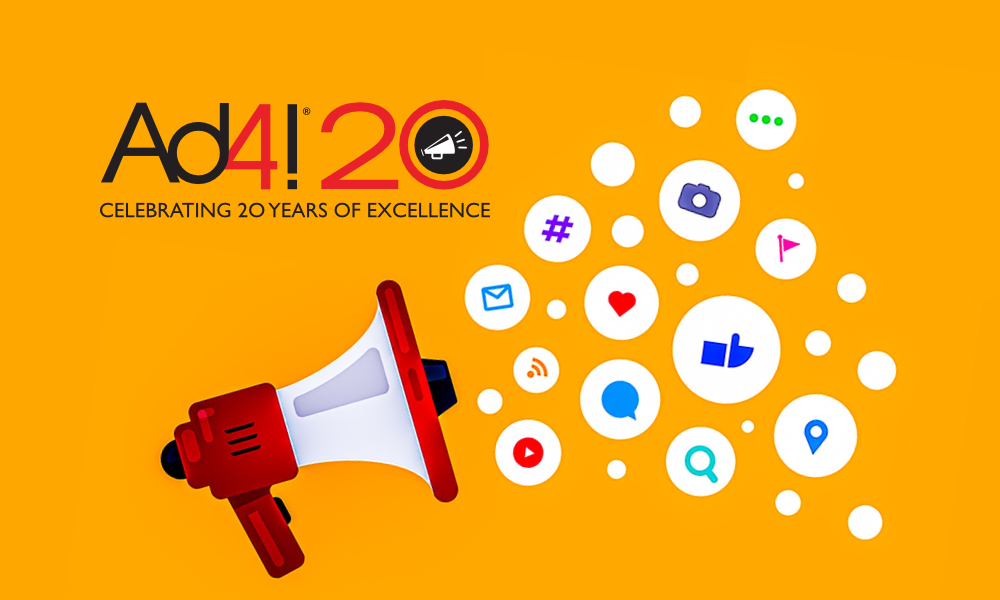As our Ad4! Group team celebrates our 20th year helping businesses and individuals with their marketing, branding, public relations, and communications needs, we can’t help but reflect on how things have changed in such a relatively short time. Technology and trends have had a huge impact on every service Ad4 offers, but one of the biggest differences, in our opinion, is the approach used to reach the right audience.
Since 2004, that approach has evolved from megaphones to fishing poles; instead of shouting at everyone at once, companies are finding more success using informational “bait” to hook and reel in just the right folks.
Now, don’t get us wrong … our Ad4! team understands the power of one-way advertising through television commercials, billboards, and newspaper or radio ads. Heck— there’s even a megaphone in our logo! But the rise of the internet, social media, and an array of technological tools have made it easier than ever to share company messaging and information about products and services with the right audience, at the right time, and in a way that invites them to reach out to learn more.
Baiting the hook
Let’s face it; people don’t like being told what to do, what they need or want, or how they should feel. However, today, more than ever, they do value another person’s opinion or recommendation and usually respect an established expert’s advice or guidance. The phenomenal success of social media influencers — people who share their own beliefs, practices, or purchases as examples for others to follow — is a great illustration of this idea.
This is the premise behind inbound or content marketing; rather than reaching out directly to consumers, companies are now finding success in creating written and video content that invites people in and makes them want to listen to what these companies have to say. This content is the proverbial bait, and when a consumer bites by reading a blog post or watching a TikTok video about a product or service, the company can reel in the consumer by feeding them more blogs, videos, and more.
An added bonus of this inbound approach is the potential for two-way communication between consumers and companies. Social media and blog platforms allow consumers to comment on posts and for companies to reply instantly, opening up an interactive dialogue that just can’t be facilitated by billboards or radio spots. Chat windows, online forums, and even in-person pop-up markets also complement these consumer-company conversations.
Favorite fishing holes
The traditional marketing and promotion techniques Ad4 and others used to promote and advertise didn’t really allow for truly strategic audience targeting. Sure, billboards would be erected alongside roads with lots of traffic, and ads would be placed in newspapers and magazines that had a high percentage of readers in a particular demographic. But accurately tracking the effectiveness of those assets was difficult and metrics were not always reliable.
Although the premise of inbound marketing seems equally haphazard — companies create content that’s out there for anyone and everyone to consume, regardless of demographics — this method actually allows for precise targeting and exceptional tracking.
Think of it this way: when a fisherman casts into the water hoping to get just one bite, he’s not there by accident. He’s done his research — he’s picked a spot where a specific kind of fish is known to live; he’s using the kind of bait that those fish will be attracted to; and he’s equipped with the right kind of rod and equipment to successfully reel in his catch.
Inbound marketing mimics these tactics. Companies produce content that their target audience normally wants to consume, whether that’s a 10-second video, a blog or website text with SEO-friendly keywords, or an attractive image with appropriate hashtags (the bait). They place that bait in the right pond, like a particular social media platform, the first page of search results, or in an ad that will be digitally displayed only to audiences who have shown interest in similar content.
As any fisherman will tell you, getting that bite is just half the battle; there’s a technique to actually hooking the fish and securely reeling it all the way into the boat. With content marketing, the key to successfully securing a consumer is to continue to feed them the kind of content they like, while at the same time pulling them closer to the company through deeper engagement. Watching a TikTok video might lead to a comment on the platform, which leads to a dialogue, which leads to an email or a website link, and perhaps even to a phone consultation or online purchase.
New tools like customer relationship management (CRM) systems track all of these interactions, compiling a robust profile of the consumer, including the types of content they’ve consumed, when and where they’ve watched or logged in, what devices they used, and much, MUCH more.
Balancing megaphones and fishing poles
While traditional outbound and newer-school techniques for getting the word out and reaching the right consumers may differ in their approaches, successful marketing and communication strategies often integrate elements of both. A balanced approach acknowledges the importance of broadcasting messages to raise awareness while actively engaging with audiences to build relationships and foster loyalty.
Understanding the preferences and behaviors of your target audience is critical in determining which approach or combination of approaches will yield the best results. By adapting and revising your strategy to align with these insights and overall consumer trends, companies can optimize engagement, enhance brand perception, and achieve their growth goals.Ad4! Group can help you build a successful, customized strategy for your particular marketing and communication needs, whether that means pulling out our red-and-white megaphone and/or fashioning the best fishing pole, creating the most effective bait, and helping you reel in your audience from a particular pond. Let’s start that two-way dialogue about your needs today!
